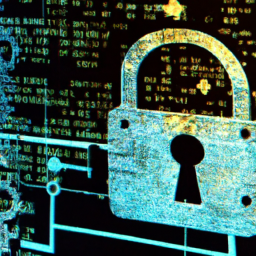What Are The Key Components Of A Cybersecurity Strategy?
When it comes to safeguarding your digital assets and protecting your sensitive information from cyber threats, having a comprehensive cybersecurity strategy is paramount. This article highlights the key components that make up an effective cybersecurity strategy. From implementing robust firewalls and encryption protocols to conducting regular security assessments and employee training programs, these essential elements provide a strong defense against potential cyberattacks. By understanding and implementing these components, you can ensure the safety and security of your digital world.
1. Risk Assessment
1.1 Identify Assets and Vulnerabilities
The first step in developing a comprehensive cybersecurity strategy is to identify the assets and vulnerabilities within your organization. This involves conducting a thorough inventory of all the digital and physical assets, such as servers, databases, and sensitive data, that need to be protected. Additionally, it is crucial to identify any vulnerabilities or weaknesses that may exist within your infrastructure, software, or processes that could be exploited by attackers.
1.2 Evaluate Threats and Risks
Once you have identified your assets and vulnerabilities, the next step is to evaluate the potential threats and risks that your organization may face. This involves assessing the likelihood and impact of different types of cyber threats, such as malware, phishing attacks, or insider threats, on your assets. By understanding the potential risks, you can prioritize your efforts and allocate resources effectively to mitigate or manage those risks.
1.3 Establish Risk Tolerance
Establishing risk tolerance is a critical component of any cybersecurity strategy. It involves determining the level of risk that your organization is willing to accept and defining the acceptable level of damage or loss that may occur due to a cybersecurity incident. This step helps in setting clear objectives and goals for your cybersecurity program and ensures that your efforts align with your organization’s overall risk appetite.
2. Security Policies and Procedures
2.1 Define Security Policies
Developing robust security policies is essential for a strong cybersecurity strategy. Security policies are documented guidelines and rules that outline the expectations and responsibilities of employees and other stakeholders in maintaining the security of the organization’s assets. These policies should cover various aspects such as data classification, password management, acceptable use of technology, incident response procedures, and more.
2.2 Develop Security Procedures
While security policies provide high-level guidance, security procedures outline the specific steps and actions that need to be taken to implement those policies. These procedures should be well-documented and easily accessible to all relevant personnel. They should cover areas such as access control processes, incident response protocols, software patching procedures, and data backup and recovery processes. Developing comprehensive security procedures ensures consistency and clarity in handling security-related tasks within the organization.
2.3 Enforce Security Policies and Procedures
Having well-defined security policies and procedures is not enough; it is essential to enforce them consistently. This involves creating a culture of security awareness and holding employees accountable for adhering to the established guidelines. Regular training sessions, awareness campaigns, and ongoing monitoring can help reinforce security practices and ensure that everyone understands the importance of following the policies and procedures.
3. Employee Training and Awareness
3.1 Provide Cybersecurity Awareness Training
One of the weakest links in any cybersecurity strategy is human error. Employees can unintentionally compromise the security of the organization through actions such as clicking on malicious links or falling for phishing scams. Providing regular cybersecurity awareness training to all employees is crucial in mitigating this risk. This training should focus on educating employees about common threats, safe browsing practices, password hygiene, and how to identify and report potential security incidents.
3.2 Conduct Regular Employee Training
In addition to cybersecurity awareness training, it is essential to provide ongoing training to employees on specific security-related topics. This could include training on new threats and emerging trends, updates on security policies and procedures, and guidance on secure remote working practices. By keeping employees up to date and informed, you can empower them to be proactive in safeguarding the organization’s assets and reducing the risk of a security breach.
3.3 Promote Security Awareness Culture
Creating a culture of security awareness is crucial for a strong cybersecurity strategy. This involves fostering a sense of personal responsibility among employees for maintaining the security of the organization. Encourage employees to report any suspicious activities, provide feedback on potential vulnerabilities, and actively participate in security-related initiatives. Recognize and reward employees who consistently demonstrate good security practices to reinforce the importance of security within the organization.
4. Access Control
4.1 Implement Strong Authentication
Implementing strong authentication measures is essential to ensure that only authorized individuals can access sensitive information or systems. This typically involves the use of multi-factor authentication (MFA), which requires users to provide multiple pieces of evidence to verify their identity. MFA can include something the user knows (such as a password), something they have (such as a security token), or something they are (such as biometric data). By implementing strong authentication, you significantly reduce the risk of unauthorized access.
4.2 Manage User Access Privileges
Controlling user access privileges is another critical aspect of access control. Assigning appropriate access levels based on job roles and responsibilities ensures that employees have only the necessary permissions to perform their duties. Regularly review and update user access privileges to prevent unauthorized access and minimize the potential damage that can result from compromised accounts. Additionally, implementing least privilege principles ensures that users have only the minimum permissions required to carry out their tasks.
4.3 Monitor and Audit User Activity
Monitoring and auditing user activity is essential for detecting any suspicious behavior or unauthorized access attempts. Implementing robust logging and monitoring systems allows you to track user actions, identify anomalies, and respond promptly to security incidents. Regularly review and analyze logs to ensure compliance with security policies and promptly investigate any suspicious activity. Logging and auditing also provide valuable information for post-incident analysis and can help identify areas where security measures can be strengthened.
5. Incident Response
5.1 Establish an Incident Response Plan
Having a well-documented incident response plan is crucial for effectively managing and responding to security incidents. This plan should outline the steps to be taken in the event of a breach or other security-related events. It should include procedures for incident detection, containment, eradication, and recovery. The incident response plan should also define roles and responsibilities, establish communication channels, and provide contact information for relevant personnel and external stakeholders.
5.2 Define Escalation and Communication Procedures
During a security incident, it is essential to have clear escalation and communication procedures in place. These procedures ensure that the right individuals are notified promptly and that the incident is escalated to the appropriate level of management. Establishing communication channels and protocols for both internal and external stakeholders, such as customers, partners, or law enforcement agencies, helps facilitate a coordinated response and ensures that everyone is kept informed throughout the incident.
5.3 Regularly Test and Update the Plan
An incident response plan is not a static document; it needs to be regularly tested, updated, and improved. Conducting simulated exercises or tabletop exercises allows you to identify any gaps or weaknesses in the plan and test the effectiveness of your response procedures. Regularly review and update the plan based on lessons learned from actual incidents or changes in the threat landscape. By continuously improving the incident response plan, you can enhance your organization’s ability to effectively respond to and recover from security incidents.
6. Network Security
6.1 Use Firewalls and Intrusion Detection/Prevention Systems
firewalls and intrusion detection/prevention systems are essential components of network security. Firewalls act as a barrier between your internal network and external networks, filtering incoming and outgoing network traffic based on predefined rules. Intrusion detection/prevention systems monitor network traffic for suspicious activity or known attack signatures and can automatically block or alert on potential threats. By implementing these technologies, you can significantly reduce the risk of unauthorized access or malicious activities within your network.
6.2 Segment the Network
Network segmentation is the practice of dividing a network into smaller, isolated segments. By segmenting the network, you contain the impact of a potential breach and prevent unauthorized lateral movement within your infrastructure. This helps limit the exposure of critical assets and sensitive data. Implementing network segmentation also allows you to apply different security controls based on the sensitivity or criticality of the assets within each segment, further strengthening your overall network security.
6.3 Regularly Monitor and Update Network Security
Regularly monitoring and updating network security measures is crucial in maintaining an effective cybersecurity strategy. This involves continuously monitoring network traffic for anomalies or suspicious behavior, regularly reviewing firewall rules and configurations, and promptly patching or updating network devices and software to address any known vulnerabilities. Implementing proactive network security practices helps detect and mitigate potential threats before they can cause significant damage or compromise your network’s security.
7. Vulnerability Management
7.1 Conduct Regular Vulnerability Assessments
Regular vulnerability assessments are essential in identifying and addressing potential security weaknesses within your infrastructure. These assessments involve scanning your network, systems, and applications for known vulnerabilities and misconfigurations. By regularly conducting vulnerability assessments, you can discover and remediate vulnerabilities before they are exploited by attackers. It is important to prioritize and address vulnerabilities based on their severity and the potential impact they may have on your organization.
7.2 Patch and Update Software
Keeping your software up to date with the latest patches and updates is crucial for mitigating security risks. Software vendors regularly release patches that address known vulnerabilities and protect against new attack techniques. Establish a patch management process that includes regularly reviewing software vendors’ security bulletins, testing patches before deployment, and ensuring timely and consistent patching across your entire infrastructure. By staying up to date with patches, you significantly reduce the chances of falling victim to known vulnerabilities.
7.3 Utilize Threat Intelligence
Leveraging threat intelligence can greatly enhance your vulnerability management efforts. Threat intelligence provides insights into the latest cyber threats, attack techniques, and emerging trends. By subscribing to threat intelligence feeds or working with external providers, you can stay informed about new vulnerabilities and the tactics used by threat actors. This knowledge enables you to proactively identify and mitigate potential risks, reducing the window of opportunity for attackers to exploit vulnerabilities within your organization.
8. Data Privacy and Encryption
8.1 Implement Data Encryption
Data encryption is a fundamental practice for protecting sensitive information from unauthorized access. Implement encryption technologies to ensure that data is only accessible to authorized individuals with the appropriate encryption keys. This includes encrypting data at rest, such as stored on servers or databases, and data in transit, such as communications between systems or over the internet. Encryption provides an additional layer of protection, even if the data is compromised or the network is breached.
8.2 Establish Data Privacy Policies
Establishing data privacy policies is crucial in ensuring that personal and sensitive information is handled appropriately and in compliance with applicable regulations. These policies should outline the requirements for collecting, storing, and sharing personal data and define the rights and responsibilities of the organization and its employees in protecting individual privacy. Adhering to data privacy policies helps build trust with customers and stakeholders and minimizes the risk of non-compliance.
8.3 Regularly Monitor and Protect Data
Regular monitoring and protection of data are key components of a cybersecurity strategy. This involves implementing data loss prevention (DLP) technologies to detect and prevent the unauthorized exfiltration of sensitive data. Robust access controls, such as role-based access privileges and encryption, should be implemented to ensure that data is only accessible to authorized individuals. Additionally, regularly monitoring data access logs and conducting periodic data quality checks helps identify and address any security gaps or anomalies in the handling of data.
9. Security Incident Monitoring and Reporting
9.1 Implement Security Incident Monitoring Tools
Implementing security incident monitoring tools allows you to proactively detect and respond to security incidents. These tools monitor network traffic, system logs, and other relevant data sources for indicators of compromise or suspicious activities. By implementing robust monitoring tools, you can quickly identify and respond to security incidents, minimizing the potential impact and reducing the time to mitigate the incident.
9.2 Establish Incident Reporting Processes
Establishing clear incident reporting processes is crucial for effective incident management. This includes defining how incidents should be reported, who should be notified, and the required information that should be included in incident reports. Establishing a centralized incident reporting mechanism ensures that all incidents are promptly documented and tracked, enabling more accurate incident analysis and better decision-making.
9.3 Analyze and Learn from Security Incidents
Every security incident provides an opportunity to learn and improve your cybersecurity strategy. Conducting thorough post-incident analysis helps identify the root causes of incidents and any weaknesses in your security controls or processes. Use this analysis to refine your incident response procedures, update security measures to address any identified gaps, and provide targeted training to employees to prevent similar incidents in the future. By continually learning and evolving, you strengthen your organization’s resilience to cyber threats.
10. Compliance and Regulations
10.1 Understand Relevant Regulations
Understanding the relevant regulations and compliance requirements is vital for developing a robust cybersecurity strategy. Depending on the nature of your organization and the industry in which you operate, you may be subject to various regulations such as the General Data Protection Regulation (GDPR), Payment Card Industry Data Security Standard (PCI DSS), or Health Insurance Portability and Accountability Act (HIPAA). Ensure that you have a clear understanding of the specific requirements and incorporate them into your cybersecurity program.
10.2 Establish Compliance Frameworks
Establishing compliance frameworks helps ensure that your organization’s cybersecurity program aligns with the applicable regulations and industry best practices. This involves creating a systematic approach to manage compliance requirements, including policies, procedures, and controls to meet the specific requirements of the regulations. Implementing compliance frameworks helps demonstrate your commitment to security and reduces the risk of non-compliance penalties or legal liabilities.
10.3 Regularly Assess and Improve Compliance
Regularly assessing and improving compliance is essential to maintaining the effectiveness of your cybersecurity strategy. Conducting periodic compliance audits and assessments helps identify any shortcomings or gaps in your compliance efforts. Address any findings or recommendations from the assessments promptly and make necessary improvements to your security controls, processes, and documentation. By continuously monitoring and improving compliance, you can ensure that your cybersecurity strategy remains robust and aligned with evolving regulations.








